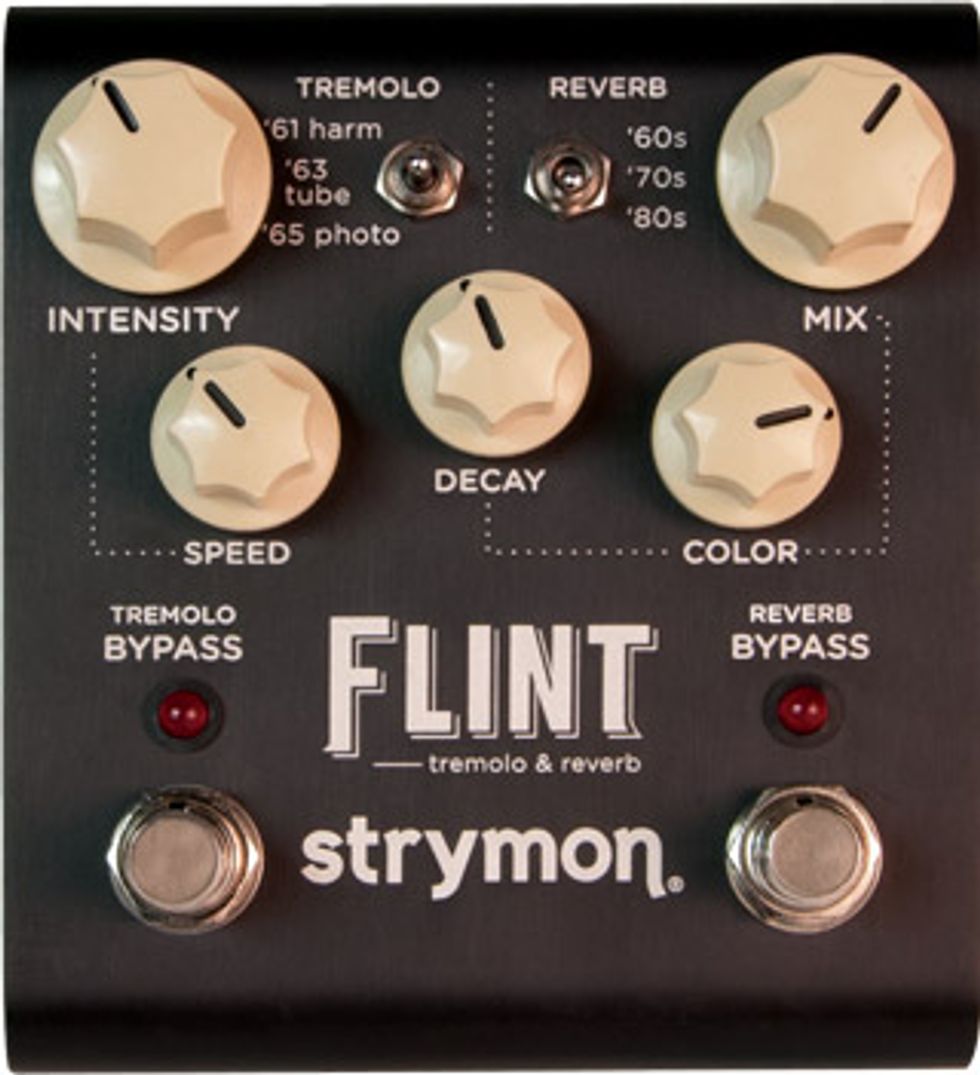
It’s been fun to watch Strymon confound analog dogmatists over the last few years. The company’s Blue Sky reverb and El Capistan delay are elegant, strikingly accurate DSP takes on difficult-to-emulate analog effects. And only the most-curmudgeonly luddite would fail to be impressed by how alive and authentic Strymon’s effects can sound.
With the introduction of the Flint, Strymon set its sights on the most ardent of analog purists. After all, the union of reverb and tremolo is the cherry on top of some very classic amps—and as a consequence, about the only effects a lot of analog devotees will touch. Not surprisingly, the Flint nails those vintage tones. But the Flint is not strictly an exercise in vintage simulation. It also enables delicious combinations of vintage colors and contemporary tones that invite creative exploration.
Spell It Out in Black
and White
Like most Strymon pedals, the
Flint is thoughtfully designed
and packs a lot of functionality
in a compact layout that’s intuitive
and not too cluttered. The
two knobs, toggle switch, and
footswitch on the left control
the tremolo section, and the
toggle moves between voices for
a harmonic dual-band filtering
tremolo (like on an old Fender
6G5 Pro Amp), a brownface-like
tube-bias-style tremolo,
and a photocell-style trem that
evokes a blackface Fender. The
three knobs, toggle switch,
and footswitch to the right are
dedicated to the reverb section,
where the toggle switches
between a ’60s tank-style voice,
a ’70s solid-state plate-style
reverb, and an ’80s digital rack-like
voice. The three knobs control
mix, color (or tone), and
decay rate.
If you want more power to tailor your sound, four of the controls have secondary functions including a +/- 3 dB boost/cut for each channels, tap-tempo divisions (from 1/16 to 1/4), and reverb/tremolo effect order.
Surfing Space,
Shape Shifting
There’s no way to do justice to
the breadth of this pedal’s capabilities
in a review of this length.
But one of the most fundamental—and satisfying—merits of
the Flint is that you don’t have
to dig too deep to reap sonic
rewards. The Flint—outside any
considerations of analog authenticity—just plain sounds good.
Set up any of the three tremolo
settings at medium intensity and
about a third of full speed, add
a little reverb, and an otherwise
no-frills amp like a Champ will
be come a mesmerizing dream
machine that makes an E minor
chord sound like blissful slumber
in Elysium.
Ratings
Pros:
Authentic, organic tones. Well-designed interface.
Exciting recombinant possibilities.
Cons:
No reverse reverb.
Tones:
Ease of Use:
Build:
Value:
Street:
$299
Strymon
strymon.net
The tremolo pulses are wonderfully organic whether they come at you with choppy intensity or in softer swells. The ’61 harm setting has a warbly, underwater, vibrato-like quality that can get delightfully queasy at high-intensity. And no matter how surgically you listen, it’s impossible to discern digital pollution or jarring right angles. It’s all lovely, fractal, blooming stuff—tinged with hints of phase and pitch shifting that sounds great at intense settings. The ’63 tube setting generates more regularly contoured swells that sound detailed at slow speeds. The ’65 photo setting is the most dramatic tremolo flavor—gloriously choppy and dramatic, and perfect for everything from Johnny Marr’s churning “How Soon is Now” riff to the slow, narcotic pulse of the Viscounts’ “Harlem Nocturne” or Spacemen 3’s opiated instruments.
The reverbs are similarly intoxicating, nuanced takes on their inspirations. The ’60s setting reproduces the fractured, irregular echoes and clanging high-end saturation you get when mix, tone, and decay are set high and long—perfect for dripping wet surf tones. The ’70s setting lends an unmistakable shag-carpet studio ambiance at low levels. But at longer decay times, it works with slow and intense tremolo settings to generate airy and very convincing rotating speaker textures. The ’80s setting, meanwhile, is the ticket to Lanois and Eno’s atmospheric states.
The Verdict
There’s plenty of precedent for
the reverb/tremolo tandem.
But what Strymon does with
the recombinant possibilities
of these particular flavors is
inspired. The Flint can move
from gutter-tough noir moods,
to sun-bleached surfscapes, to
time-and-space-stretching ambience
with a few simple tweaks.
The ease with which you can
access the full range of sounds and tone-shaping capabilities
is a minor masterpiece of
stompbox-interface engineering
too. But above all, it’s the quality
and authenticity of tones that
impresses. Strymon’s work on
this front will no doubt delight
DSP believers and those that
listen with open ears. But this
pedal is bound the change the
minds of more than a few analog
purists, and that may be the ultimate
testimonial to how good
the Flint can be.








![Rig Rundown: Russian Circles’ Mike Sullivan [2025]](https://www.premierguitar.com/media-library/youtube.jpg?id=62303631&width=1245&height=700&quality=70&coordinates=0%2C0%2C0%2C0)

















